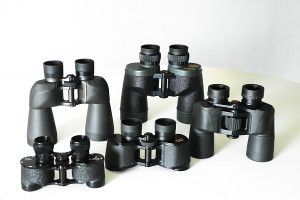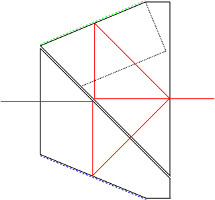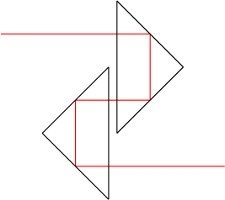Why I don't dismiss the Porro binocular
 Porro binoculars are commonly regarded bulky, antiquated, generally
not up to technical standards or simply out of fashion. On the high
end market, they are absent altogether, the medium range offers a
few of them, which are collecting dust on the store's shelves, while
only in the supermarkets, cheap Porro models are selling well for a
couple of Euros. A few gems still exist, but it requires more than a
bit of insider knowledge to come to know about them, locate and order
them on the Internet. In my opinion, this is a sad situation, and -
in fact - the Porro design has deserved better than dwelling inside the
closets of a handful of binoculars collectors and historians.
Why do I think so?
Porro binoculars are commonly regarded bulky, antiquated, generally
not up to technical standards or simply out of fashion. On the high
end market, they are absent altogether, the medium range offers a
few of them, which are collecting dust on the store's shelves, while
only in the supermarkets, cheap Porro models are selling well for a
couple of Euros. A few gems still exist, but it requires more than a
bit of insider knowledge to come to know about them, locate and order
them on the Internet. In my opinion, this is a sad situation, and -
in fact - the Porro design has deserved better than dwelling inside the
closets of a handful of binoculars collectors and historians.
Why do I think so?
Being somebody who is interested in binocular technology,
who likes to know how these instruments function and perform,
I have learned to appreciate simple solutions. Optical instruments
are machines that modify light, and light is a rather ethereal
entity that has to be treated with great care in order to preserve
its valuable information content. The image reversal prism is
a necessary, though unpleasant optical group of the
binocular - a block of glass that is not only heavy,
but contributing the bulk of the optical glass path which has
to be traveled by the light, longer than the glass paths of
all lenses taken together. Transparency, color hue, bubbles,
inclusions and mechanical strain are but a few of the issues which the
prisms are involved with. Astronomers are happy to leave them
out of the optical path altogether and rather watch the
planets upside down than messing around with these bulky
blocks of glass.

 But with modern binoculars, there are additional issues. Most
roof-binoculars are of the Schmidt-Pechan type (left figure),
which is favored over alternative designs because of its outstanding
compactness. An entire
bunch of technical problems are coming along with this prism: The
total internal reflection of the light beam fails at the lower
left edge, because the incident angle is too steep. This requires
an external mirror, coated on top of the surface
(blue) in more than 30 dielectric layers
of highest precision, before approaching the reflectivity of
the total internal reflection. On the second prism, there is the
roof (here seen as a projection of one of its flanks) which has to be coated with another
"P-coating" to reduce polarization effects of the beam and a
corresponding loss of resolution. The roof edge, shown in
green, is cutting right through the cross-section of the light beam and
adding a diffractive distortion that generates the well known
spikes when imaging intense light sources. The air-space between
the two prisms is narrow, but necessary - the both blocks cannot
possibly be cemented together. But it comes even worse: The prism
faces, which are separated by the air-gap, cannot be multi-coated
without triggering the side-effect of a contrast reduction (see: Konrad
Seil, "Progress in binocular design", Proc. of SPIE Vol. 1553,
p. 48, 1991). This is so because these surfaces have to serve
a dual purpose, a total reflection and also a transmission of
the light cone. Total internal reflection does not remain
unaffected by the external coating layers, leading to
the image degradation mentioned by Seil.
But with modern binoculars, there are additional issues. Most
roof-binoculars are of the Schmidt-Pechan type (left figure),
which is favored over alternative designs because of its outstanding
compactness. An entire
bunch of technical problems are coming along with this prism: The
total internal reflection of the light beam fails at the lower
left edge, because the incident angle is too steep. This requires
an external mirror, coated on top of the surface
(blue) in more than 30 dielectric layers
of highest precision, before approaching the reflectivity of
the total internal reflection. On the second prism, there is the
roof (here seen as a projection of one of its flanks) which has to be coated with another
"P-coating" to reduce polarization effects of the beam and a
corresponding loss of resolution. The roof edge, shown in
green, is cutting right through the cross-section of the light beam and
adding a diffractive distortion that generates the well known
spikes when imaging intense light sources. The air-space between
the two prisms is narrow, but necessary - the both blocks cannot
possibly be cemented together. But it comes even worse: The prism
faces, which are separated by the air-gap, cannot be multi-coated
without triggering the side-effect of a contrast reduction (see: Konrad
Seil, "Progress in binocular design", Proc. of SPIE Vol. 1553,
p. 48, 1991). This is so because these surfaces have to serve
a dual purpose, a total reflection and also a transmission of
the light cone. Total internal reflection does not remain
unaffected by the external coating layers, leading to
the image degradation mentioned by Seil.
On the contrary, the Porro prism (right figure) makes matters
very easy for the light cone to pass: Four times of perfect
internal reflections without the need of any special coatings,
apart from the standard anti-reflex coatings at the prism
entrance and exit. The air-space between the two
prisms can either be left open and the corresponding surfaces
be multi-coated without any side effects, or the prisms
are cemented to eliminate any transmission losses altogether.
Porro prisms are bulkier than Schmidt-Pechan prisms:
The weight of a symmetric Porro is 11% higher than that of a
Schmidt-Pechan with identical entrance diameter, and the
Schmidt-Pechan is also both shorter and significantly slimmer.
Its glass path, however, is 16% longer than that of a comparable
Porro, due to the multiple folding of the beam. Tolerances during
the process of shaping differ dramatically: The 90 degree
right-angle of the roof-edge
has to be accurate to a few arc seconds in order to guaranty
a high resolution - compared to these numbers, tolerances of
the Porro geometry can be relaxed by a factor of ten.
Modern technologies allow manufacturers to make high end
roof prisms that rival the optical performance of the Porro -
but not its simplicity and conceptual elegance. The making
of Porro binoculars of highest optical performance would be
possible, and with very competitive price tags - if only they
were asked for by the consumers.
Back Home
Last updated: Aug. 2013
 Porro binoculars are commonly regarded bulky, antiquated, generally
not up to technical standards or simply out of fashion. On the high
end market, they are absent altogether, the medium range offers a
few of them, which are collecting dust on the store's shelves, while
only in the supermarkets, cheap Porro models are selling well for a
couple of Euros. A few gems still exist, but it requires more than a
bit of insider knowledge to come to know about them, locate and order
them on the Internet. In my opinion, this is a sad situation, and -
in fact - the Porro design has deserved better than dwelling inside the
closets of a handful of binoculars collectors and historians.
Why do I think so?
Porro binoculars are commonly regarded bulky, antiquated, generally
not up to technical standards or simply out of fashion. On the high
end market, they are absent altogether, the medium range offers a
few of them, which are collecting dust on the store's shelves, while
only in the supermarkets, cheap Porro models are selling well for a
couple of Euros. A few gems still exist, but it requires more than a
bit of insider knowledge to come to know about them, locate and order
them on the Internet. In my opinion, this is a sad situation, and -
in fact - the Porro design has deserved better than dwelling inside the
closets of a handful of binoculars collectors and historians.
Why do I think so? 
